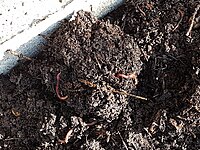
Photo from wikipedia
Soil macrofauna is an important component of soil biodiversity and plays a key role in soil ecosystem function. Little work, however, has explored how macrofauna may contribute, directly or indirectly,… Click to show full abstract
Soil macrofauna is an important component of soil biodiversity and plays a key role in soil ecosystem function. Little work, however, has explored how macrofauna may contribute, directly or indirectly, to soil microfauna communities. In this study, we explored the impact of two classes of common soil macrofauna, earthworms (Eisenia foetida) and millipedes (Spirobolus walkeri), on soil nematode community diversity and structure. We found that earthworms and millipedes play an important role in maintaining soil nematode communities and increasing soil nutrients. Both earthworms and millipedes act as hosts for soil nematodes, and play a valuable role in dispersing and distributing these important microfauna throughout the soil landscape. We tested the efficacy of this strategy on multiple soil layers and found that layer does not have a significant influence on soil nematode community. These results suggest that soil nematode abundance, diversity, and structure are tightly linked to the existence of soil macrofauna, which may contribute to the maintenance mechanism of forest soil biodiversity.
Journal Title: Forests
Year Published: 2023
Link to full text (if available)
Share on Social Media: Sign Up to like & get
recommendations!